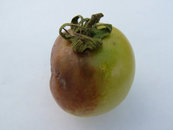|
Yes, you can, if they are heritage varieties rather than modern hybrid varieties. Click here to go to our page on tomatoes with more info.
0 Comments
If you have planted your potatoes in spring, no doubt they are all lifted and stored by now. There is no advantage in leaving them in the ground a minute after the haulm has died down, as it only leaves them vulnerable to slug attack.
If you have planted potatoes late because you have recently taken on your plot, or if you are trying out planting late summer for new potatoes in the autumn, you need to be aware that there is a very great deal of blight around right now, and the humid warm conditions mean it will spread quickly. Potato blight also affects outdoor tomatoes. It is worth taking extra care not to allow blight to infest your plot from year to year. You can protect potatoes, as well as tomatoes, from blight by spraying with Bordeaux mixture. Click here for a particularly clear article on potato blight. For more about Bordeaux mixture click here. For our own page on growing potatoes click here  Blight on a tomato. Blight on a tomato. Spells of warm, humid weather mean blight. Blight is a fungus disease, spread by rain and wind, affecting both potatoes and tomatoes. The first signs are small patches of brown on the foliage, with the damaged areas drying and shrinking. Click on the pic (left) to go to the RHS advice page. Blight can be prevented by spraying with Bordeaux Mixture - a post which said Bordeaux mixture was to be withdrawn, on this page, was MISTAKEN - your website compiler was reading info on the RHS website wrong. There have been a number of attempts to withdraw Bordeaux mixture over the years but it is still currently available. If you spray with Bordeaux mixture you will need to re-apply it after rain! On tomatoes, pick off any affected leaves and burn or bin them (don't compost diseased material), spraying with bordeaux mixture to stop it spreading. Tomatoes in greenhouses, protected from the rain, are less vulnerable. If your potatoes have already formed a decent crop - and I don't know about you, but my 'first earlies' are the size of maincrop, while my 'second earlies' rival some of the smaller moons of Jupiter - then you can simply cut off all the foliage and bin it. Thus will stop the blight migrating down to the spuds and you can lift them in your own time. If there is any suggestion that blight might be about, store your potatoes in hessian sacks rather than paper. If you don't have a nice dark cellar (how many of us have one of those?) Then use the sacks double to keep out the light. Because of the exceptional weather, many late autumn and midwinter jobs probably remain undone. Don’t forget to prune soft fruit (I still haven't done mine!), and autumn-fruiting raspberries can be cut to ground level now if you haven’t already done them. Burn or bin the prunings to get rid of cane-boring caterpillar and “cane blight”, both of which are more trouble for summer-fruiting varieties, but which may be present in the old canes of autumn-fruiters. If you are only now pruning blackcurrants, it is probably still worth sticking some of the younger shoots, pruned off because they are in the wrong place, in the ground to see if they will still root. Of course we should have done this in December, but blackcurrants are tough . . .  If you intend to grow flowers for cutting, check your seed packets. Though it seems hard to imagine summer at the moment, carnations, late sweet peas, antirrhinums and many other cut flowers are sown in the propagator now. Leave it too late and you won’t get the results you want. You can also start sowing tomatoes and peppers now for growing in an unheated greenhouse. There is still time to start onions off from seed. Sort out your main seeds so you know what will be going later this month. Spring WILL arrive and the gorund will, eventually dry up. Don't be caught on the hop! Looking at what people are talking about online, it's clear some beginners are starting cucumbers and other tender stuff off already. This is too early unless you have the facilities to grow them on under heated protection till it is safe to plant out.
Yes, you can start off tomatoes now, and peppers especially need a long growing season. But you must be ready to keep them at a minumum temperature of 5degC at night (and more in the daytime) till mid-April if you have a greenhouse, and till the beginning of May at the earliest if you are planning to grow them outside. This means having a conservatory at your house, or supplying artificial heat in your greenhouse. (A sunny windowsill rarely gets enough light). If you can't provide these conditions, you are better delaying sowing or even just buying well-grown plants at bootfairs, where they are usually very cheap even if the range of varieties is restricted. When growing plants with artificial heat - either on a windowsill or in a propagator - you must balance the heat with the available light. Too much heat for the amount of light will make your seedlings grow tall, spindly and weak. They will be more vulnerable to disease and may not be able to survive the transition to cooler conditions. Check out the Help and Advice section - "Why are my seedlings so spindly?" |
Kent's climate is drier, hotter and has a longer growing season than the average for the UK. Advice in gardening books may not fit Kent. This blog has local tips on what will grow and when to do garden jobs.
SEND YOUR SEASONAL SUGGESTIONS IN BY USING OUR ONLINE POSTBOX Archives
December 2015
Categories
All
|

 RSS Feed
RSS Feed
